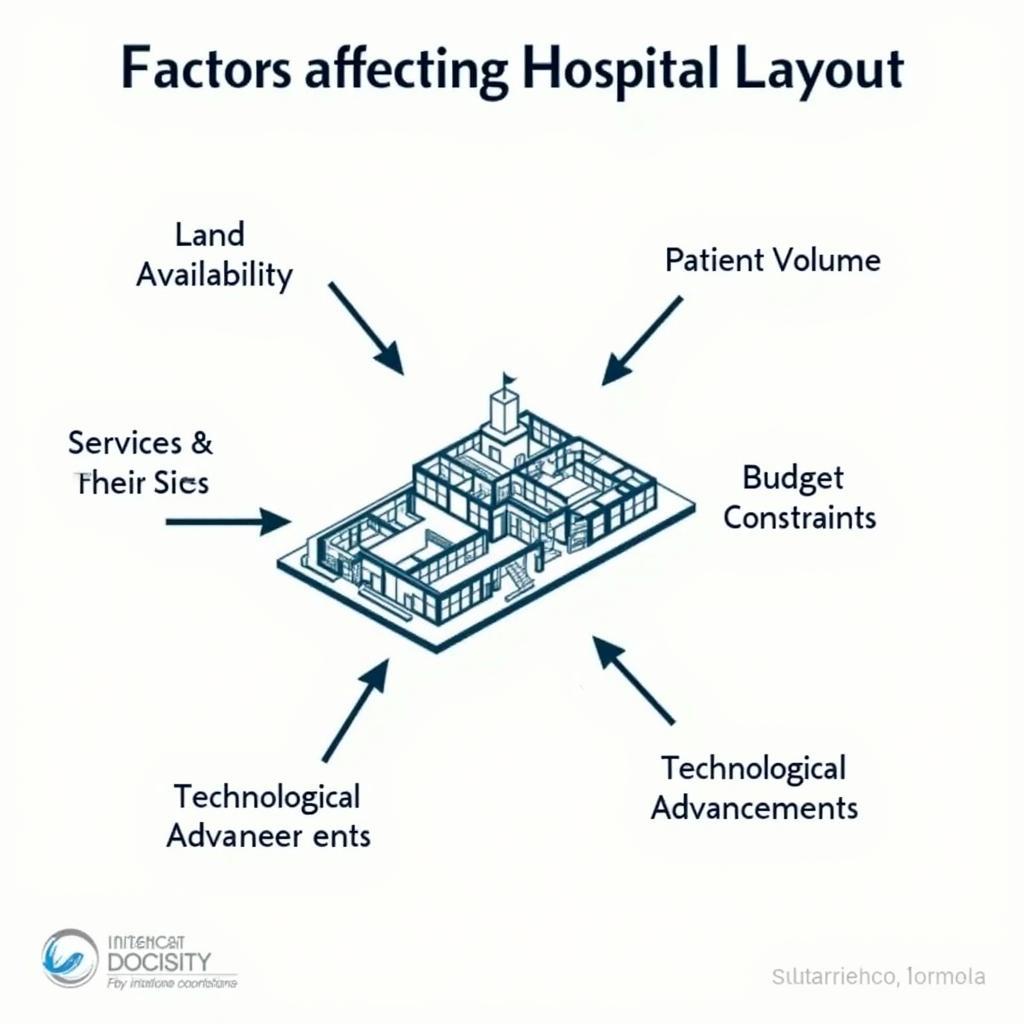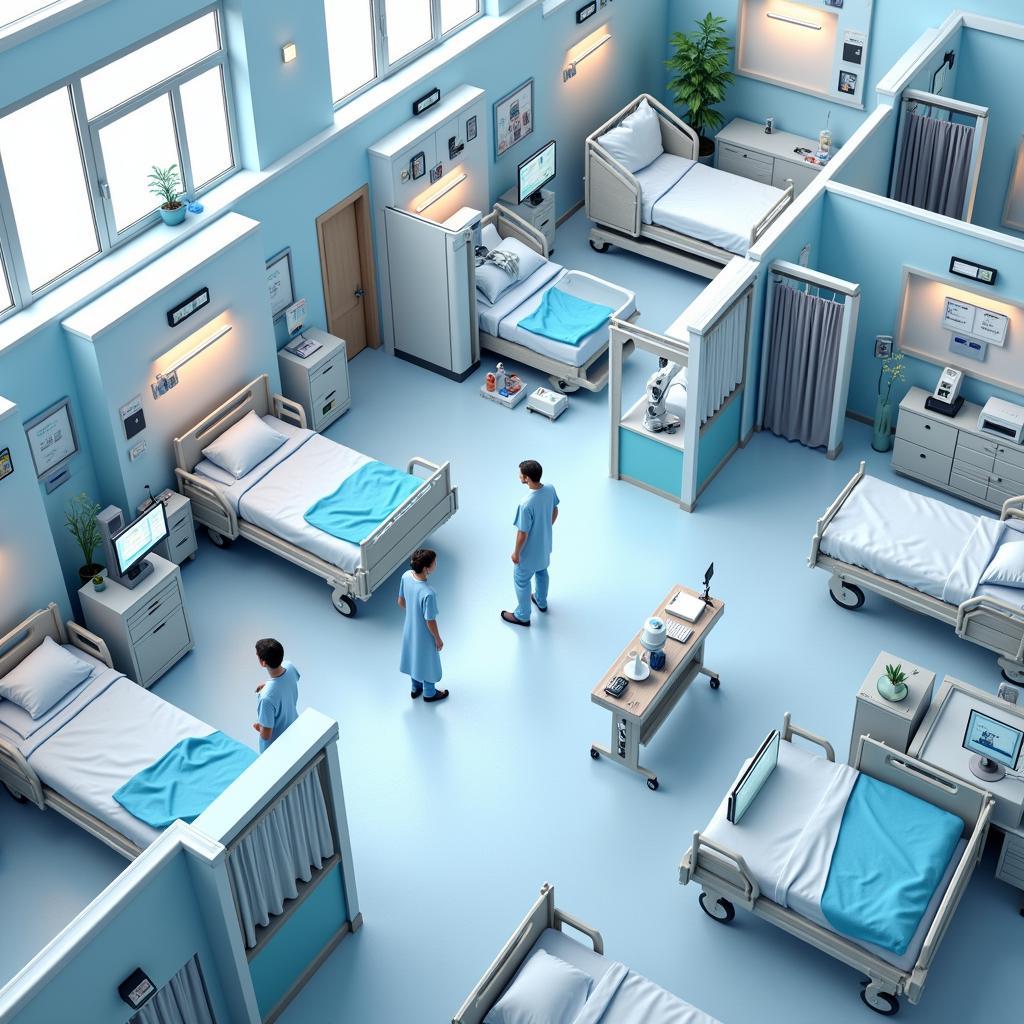The Layout Of A Hospital plays a crucial role in its efficiency, patient experience, and overall success. A well-designed hospital layout optimizes patient flow, improves staff productivity, and enhances safety. In this article, we’ll delve into the complexities of hospital layouts, exploring various models and considerations for creating an effective and healing environment.
 Example of a Modern Hospital Layout
Example of a Modern Hospital Layout
Key Principles of an Effective Hospital Layout
Hospital layouts are far from arbitrary; they are carefully planned based on specific principles. These principles ensure efficient movement of patients, staff, and resources. One core principle is departmentalization, grouping related services together to minimize travel time and maximize collaboration among medical professionals. Another principle is circulation, optimizing patient and staff movement through clear pathways and minimizing congestion. Flexibility is also key, allowing for future expansion and adaptation to evolving healthcare needs.
Accessibility is another critical factor in hospital layout design. Hospitals must cater to patients with diverse needs, including those with disabilities. This means incorporating ramps, elevators, and accessible restrooms throughout the facility. Wayfinding is equally important; clear signage and intuitive navigation are crucial to helping patients and visitors easily find their way around a potentially complex building.
Different Models of Hospital Layouts
Several models guide hospital layout design, each with its own strengths and weaknesses. The radial plan, for example, features a central core with departments radiating outwards. This design promotes efficient access to core services. The racetrack plan, on the other hand, arranges departments along a looped corridor, facilitating easy movement between departments. The pavilion plan consists of separate buildings connected by corridors, offering flexibility and potential for expansion.
What are the factors influencing hospital layout design?
Several factors influence the final layout of a hospital. These include the size and shape of the available land, the projected patient volume, the range of services offered, and the budget. Technological advancements also play a significant role, influencing the design of operating rooms, imaging departments, and other specialized areas.
 Factors Influencing Hospital Layout Design
Factors Influencing Hospital Layout Design
The Importance of Patient-Centered Design
Modern hospital layout design increasingly emphasizes patient-centered care. This approach prioritizes patient comfort, privacy, and well-being. It involves designing spaces that are calming, aesthetically pleasing, and conducive to healing. This includes incorporating natural light, artwork, and access to outdoor spaces.
How can technology improve hospital layouts?
Technology is transforming hospital layouts in numerous ways. Automated guided vehicles (AGVs) can transport supplies and equipment, reducing the need for manual handling and freeing up staff time. Real-time location systems (RTLS) can track patients and equipment, improving efficiency and safety.
“Designing a patient-centered hospital requires a deep understanding of the patient journey and a commitment to creating a healing environment,” says Dr. Emily Carter, a leading healthcare architect. “It’s about more than just functionality; it’s about creating a space that supports physical and emotional well-being.”
The Future of Hospital Layouts
The layout of a hospital is constantly evolving to meet the changing needs of healthcare. Future hospital designs will likely incorporate more flexible spaces, adaptable to changing technologies and evolving models of care. Telemedicine and remote monitoring will play an increasingly important role, influencing the design of patient rooms and consultation areas.
 The Future of Hospital Layouts
The Future of Hospital Layouts
“The future of hospital design lies in creating adaptable and technologically advanced spaces that prioritize patient-centered care,” adds Dr. Michael Davis, a hospital administrator with over 20 years of experience. “We need to create environments that empower patients and support their healing journey.”
que significa una pulsera amarilla en un hospital
In conclusion, the layout of a hospital is a complex and dynamic field that significantly impacts patient care, staff efficiency, and overall operational success. By understanding the key principles and embracing innovative design strategies, hospitals can create environments that promote healing, enhance efficiency, and adapt to the ever-changing landscape of healthcare.
For assistance, please contact us at Phone Number: 02437655121, Email: [email protected] Or visit us at: 298 Cau Dien Street, Minh Khai, Bac Tu Liem, Hanoi, Vietnam. We have a 24/7 customer service team.